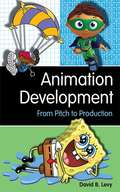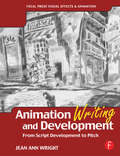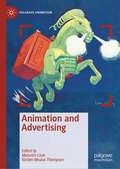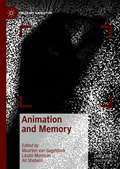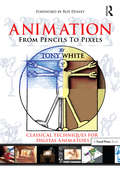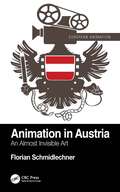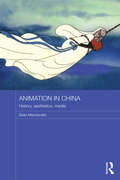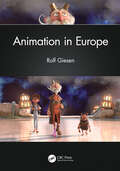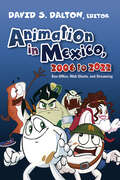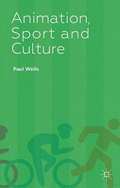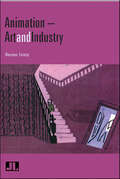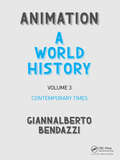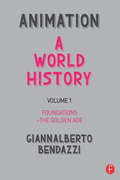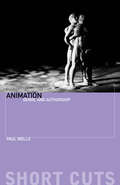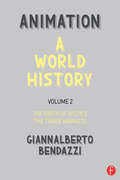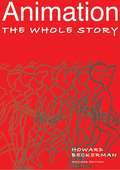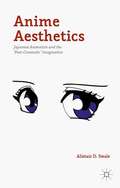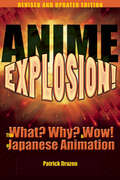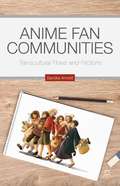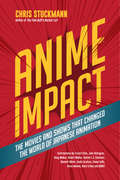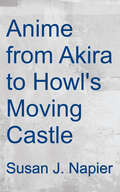- Table View
- List View
Animation Development: From Pitch to Production
by David B. LevyWhether a novice curious about the cartoon production process, a visual arts student who has not yet experienced that big break, or a seasoned professional looking for valuable insight, Animation Development is the go-to guide for creating the perfect pitch. David Levy has been through every aspect of the pitching process--preparation, hope, rejection, success- and now he wraps up his valuable experience to deliver this comprehensive guide on the industry and process. Animation Development will help readers discover how to tap into their creativity to develop something personal yet universal, push projects through collaborations and partnerships, set up pitch meetings, get legal representation and agents, and manage the emotional roller-coaster common to the pitching and development process.
Animation Writing and Development: From Script Development to Pitch
by Jean Ann WrightThe art. The craft. The business. Animation Writing and Development takes students and animation professionals alike through the process of creating original characters, developing a television series, feature, or multimedia project, and writing professional premises, outlines and scripts. It covers the process of developing presentation bibles and pitching original projects as well as ideas for episodes of shows already on the air. Animation Writing and Development includes chapters on animation history, on child development (writing for kids), and on storyboarding. It gives advice on marketing and finding work in the industry. It provides exercises for students as well as checklists for professionals polishing their craft. This is a guide to becoming a good writer as well as a successful one.
Animation and Advertising (Palgrave Animation)
by Kirsten Moana Thompson Malcolm CookThroughout its history, animation has been fundamentally shaped by its application to promotion and marketing, with animation playing a vital role in advertising history. In individual case study chapters this book addresses, among others, the role of promotion and advertising for anime, Disney, MTV, Lotte Reiniger, Pixar and George Pal, and highlights American, Indian, Japanese, and European examples. This collection reviews the history of famous animation studios and artists, and rediscovers overlooked ones. It situates animated advertising within the context of a diverse intermedial and multi-platform media environment, influenced by print, radio and digital practices, and expanding beyond cinema and television screens into the workplace, theme park, trade expo and urban environment. It reveals the part that animation has played in shaping our consumption of particular brands and commodities, and assesses the ways in which animated advertising has both changed and been changed by the technologies and media that supported it, including digital production and distribution in the present day. Challenging the traditional privileging of art or entertainment over commercial animation, Animation and Advertising establishes a new and rich field of research, and raises many new questions concerning particular animation and media histories, and our methods for researching them.
Animation and Memory (Palgrave Animation)
by László Munteán Maarten Van Gageldonk Ali ShobeiriThis book examines the role of memory in animation, as well as the ways in which the medium of animation can function as a technology of remembering and forgetting. By doing so, it establishes a platform for the cross-fertilization between the burgeoning fields of animation studies and memory studies. By analyzing a wide range of different animation types, from stop motion to computer animation, and from cell animated cartoons to painted animation, this book explores the ways in which animation can function as a representational medium. The five parts of the book discuss the interrelation of animation and memory through the lens of materiality, corporeality, animation techniques, the city, and animated documentaries. These discussions raise a number of questions: how do animation films bring forth personal and collective pasts? What is the role of found footage, objects, and sound in the material and affective dimensions of animation? How does animation serve political ends? The essays in this volume offer answers to these questions through a wide variety of case studies and contexts. The book will appeal to both a broad academic and a more general readership with an interest in animation studies, memory studies, cultural studies, comparative visual arts, and media studies.
Animation from Pencils to Pixels: Classical Techniques for the Digital Animator (Animation Foundation Bundle Ser.)
by Tony WhiteJust add talent!Award-winning animator Tony White brings you the ultimate book for digital animation. Here you will find the classic knowledge of many legendary techniques revealed, paired with information relevant to today's capable, state-of-the-art technologies.White leaves nothing out. What contemporary digital animators most need to know can be found between this book's covers - from conceptions to creation and through the many stages of the production pipeline to distribution. This book is intended to serve as your one-stop how-to animation guide. Whether you're new to animation or a very experienced digital animator, here you'll find fundamentals, key classical techniques, and professional advice that will strengthen your work and well-roundedness as an animator.Speaking from experience, White presents time-honored secrets of professional animaton with a warm, masterly, and knowledgeable approach that has evolved from over 30 years as an award-winning animator/director.The book's enclosed downloadable resources presents classic moments from animation's history through White's personal homage to traditional drawn animation, "Endangered Species." Using movie clips and still images from the film, White shares the 'making of' journal of the film, detailing each step, with scene-by-scene descriptions, technique by technique. Look for the repetitive stress disorder guide on the downloadable resources, called, "Mega-hurts." Watch the many movie clips for insights into the versatility that a traditional, pencil-drawn approach to animaton can offer.
Animation in Austria: An Almost Invisible Art (European Animation)
by Florian SchmidlechnerThis book provides a comprehensive account of Austrian animation history, as well as an analysis of the current state of the industry in competition with American and cheaper international products in the face of dwindling budgets.The book outlines the history of Austrian animated film from the actual beginnings at the time of the First World War. It looks at the reconstruction of the animation industry during the 1950s and 60s and covers experimental animation from the 1970s onwards. The final part of the book explores modern Austrian animation and looks ahead to the future of animation production within the country.This book will be of great interest to academics, students, and professionals working and researching in the field of animation.
Animation in China: History, Aesthetics, Media (Routledge Contemporary China Series)
by Sean MacdonaldBy the turn of the 21st century, animation production has grown to thousands of hours a year in the People’s Republic of China (PRC). Despite this, and unlike American blockbuster productions and the diverse genres of Japanese anime, much animation from the PRC remains relatively unknown. This book is an historical and theoretical study of animation in the PRC. Although the Wan Brothers produced the first feature length animated film in 1941, the industry as we know it today truly began in the 1950s at the Shanghai Animation Film Studio (SAFS), which remained the sole animation studio until the 1980s. Considering animation in China as a convergence of the institutions of education, fine arts, literature, popular culture, and film, the book takes comparative approaches that link SAFS animation to contemporary cultural production including American and Japanese animation, Pop Art, and mass media theory. Through readings of classic films such as Princess Iron Fan, Uproar in Heaven, Princess Peacock, and Nezha Conquers the Dragon King, this study represents a revisionist history of animation in the PRC as a form of "postmodernism with Chinese characteristics." As a theoretical exploration of animation in the People’s Republic of China, this book will appeal greatly to students and scholars of animation, film studies, Chinese studies, cultural studies, political and cultural theory.
Animation in Europe
by Rolf GiesenThere is a lot one could say about animation in Europe, but above all, there is no consistent European animation. It is as disparate as the various countries involved. Audiences will certainly recognize American or Japanese animation, but in Europe, it can range from Czech, Polish, and Hungarian to Greek, Italian, Spanish, Portuguese, French, and British. Animation in Europe provides a comprehensive review of the history and current situation of animation in over 20 European countries. It features numerous interviews with artists and producers, including rare documents and firsthand accounts that illustrate the rich history of animation in Europe. Additional features include • An extensive chronology with key events in European animation • A Who’s Who of producers, directors, writers, and animators working in Europe • An examination of the origin of European animation and its influence Animation in Europe is the first book devoted entirely to this topic and, therefore, will be of value for animation buffs as well as practitioners and researchers.
Animation in Mexico, 2006 to 2022: Box Office, Web Shorts, and Streaming (SUNY series in Latin American Cinema)
by David S. DaltonExamines contemporary animation in Mexico—one of the most commercially successful and most understudied genres of the national cinema.Answering a call to view Mexican film through the lens of commercial cinema, Animation in Mexico, 2006 to 2022 is the first book-length study of the country's animated cinema in the twenty-first century. As such, the volume sheds light on one of the country's most strategically important and lucrative genres, subjecting it to sustained intellectual analysis for the first time. Building on earlier film history, David S. Dalton identifies two major periods, during which the focus shifted from success at the national box office to internationalization and streaming. In eight original essays, contributors use an array of theoretical and disciplinary approaches to interrogate how this popular genre interfaces with Mexican politics and society more broadly, from Huevocartoon to Coco and beyond. The book will appeal to students, scholars, and fans of Mexican film by situating animation within broader currents in the field and the industry.
Animation in Spain: Magic Tricks, Drawings on Cels, and CGI (European Animation)
by Maria Pagès RoviraThis book provides a comprehensive account of Spanish animation history, from its early days through to the arrival of CGI. It examines the two main centers of production, Barcelona and Madrid, as well as evolving animation hubs in the Basque Country and Galicia. This book also pays tribute to the women who were significant to the animation industry and had been invisible for many years, highlighting more recent attempts to achieve equality in the Spanish animation industry thanks to help from the government and women’s associations looking to balance the inequality in this domain. This book will be of great interest to academics, students, and professionals working and researching in the field of animation.
Animation, Sport and Culture
by Paul WellsAnimation, Sport and Culture is a wide-ranging study of both sport and animated films. From Goofy to Goalkeepers, Wallace and Gromit to Tiger Woods, Mickey Mouse to Messi, and Nike to Nationhood, this Olympic-sized analysis looks at the history, politics, aesthetics and technologies of sport and animation from around the globe.
Animation: Art and Industry
by Maureen FurnissAnimation—Art and Industry is an introductory reader covering a broad range of animation studies topics, focusing on both American and international contexts. It provides information about key individuals in the fields of both independent and experimental animation, and introduces a variety of topics relevant to the critical study of media—censorship, representations of gender and race, and the relationship between popular culture and fine art. Essays span the silent era to the present, include new media such as web animation and gaming, and address animation made using a variety of techniques.
Animation: Contemporary Times
by Giannalberto BendazziA continuation of 1994's groundbreaking Cartoons, Giannalberto Bendazzi's Animation: A World History is the largest, deepest, most comprehensive text of its kind, based on the idea that animation is an art form that deserves its own place in scholarship. Bendazzi delves beyond just Disney, offering readers glimpses into the animation of Russia, Africa, Latin America, and other often-neglected areas and introducing over fifty previously undiscovered artists. Full of first-hand, never before investigated, and elsewhere unavailable information, Animation: A World History encompasses the history of animation production on every continent over the span of three centuries. Volume III catches you up to speed on the state of animation from 1991 to present. Although characterized by such trends as economic globalization, the expansion of television series, emerging markets in countries like China and India, and the consolidation of elitist auteur animation, the story of contemporary animation is still open to interpretation. With an abundance of first-hand research and topics ranging from Nickelodeon and Pixar to modern Estonian animation, this book is the most complete record of modern animation on the market and is essential reading for all serious students of animation history.
Animation: Foundations - The Golden Age
by Giannalberto BendazziA continuation of 1994's groundbreaking Cartoons, Giannalberto Bendazzi's Animation: A World History is the largest, deepest, most comprehensive text of its kind, based on the idea that animation is an art form that deserves its own place in scholarship. Bendazzi delves beyond just Disney, offering readers glimpses into the animation of Russia, Africa, Latin America, and other often-neglected areas and introducing over fifty previously undiscovered artists. Full of first-hand, never before investigated, and elsewhere unavailable information, Animation: A World History encompasses the history of animation production on every continent over the span of three centuries. Volume I traces the roots and predecessors of modern animation, the history behind Émile Cohl's Fantasmagorie, and twenty years of silent animated films. Encompassing the formative years of the art form through its Golden Age, this book accounts for animation history through 1950 and covers everything from well-known classics like Steamboat Willie to animation in Egypt and Nazi Germany. With a wealth of new research, hundreds of photographs and film stills, and an easy-to-navigate organization, this book is essential reading for all serious students of animation history.
Animation: Genre and Authorship (Short Cuts)
by Paul WellsAnimation: Genre and Authorship explores the distinctive language of animation, its production processes, and the particular questions about who makes it, under what conditions, and with what purpose. In this first study to look specifically at the ways in which animation displays unique models of ‘auteurism’ and how it revises generic categories, Paul Wells challenges the prominence of live-action moviemaking as the first form of contemporary cinema and visual culture. The book also includes interviews with Ray Harryhausen and Caroline Leaf, and a full timeline of the history of animation.
Animation: The Birth of a Style - The Three Markets
by Giannalberto BendazziA continuation of 1994's groundbreaking Cartoons, Giannalberto Bendazzi's Animation: A World History is the largest, deepest, most comprehensive text of its kind, based on the idea that animation is an art form that deserves its own place in scholarship. Bendazzi delves beyond just Disney, offering readers glimpses into the animation of Russia, Africa, Latin America, and other often-neglected areas and introducing over fifty previously undiscovered artists. Full of first-hand, never before investigated, and elsewhere unavailable information, Animation: A World History encompasses the history of animation production on every continent over the span of three centuries. Volume II delves into the decades following the Golden Age, an uncertain time when television series were overshadowing feature films, art was heavily influenced by the Cold War, and new technologies began to emerge that threatened the traditional methods of animation. Take part in the turmoil of the 1950s through 90s as American animation began to lose its momentum and the advent of television created a global interest in the art form. With a wealth of new research, hundreds of photographs and film stills, and an easy-to-navigate organization, this book is essential reading for all serious students of animation history.
Animation: The Whole Story
by Howard BeckermanProfessional animator Howard Beckerman has drawn them all: Popeye, Heckle & Jeckle, even Mickey Mouse. In Animation, he offers a road map to the complex art of making an animated feature. Vivid sketches, screen shots, and step-by-step illustrations show how to make a drawing come to life, create storyboards, use form and color, develop a soundtrack, edit, and more. This new edition is also thoroughly updated to reflect the latest trends surrounding digital technology. Animation provides artists and aspiring filmmakers with everything they need to carve their niche in today's quickly evolving animation industry.
Animator (Cool Cutting Edge Careers)
by Jessica CohnIf you've seen a movie made with computer graphics, played one of the latest video games, or even just watched cartoons on a Saturday morning, then you've seen what animators do. Learn all about how animators work to create the movies, games, and TV shows that you love. Hear from the animators themselves about what it takes to make it in this exciting career.
Anime Aesthetics: Japanese Animation And The 'post-cinematic' Imagination (New Security Challenges)
by Alistair D. SwaleJapanese animation has been given fulsome academic commentary in recent years. However, there is arguably a need for a more philosophically consistent and theoretically integrated engagement. While this book covers the key thinkers of contemporary aesthetic theory, it aims to reground reflection on anime within the aesthetics of R.G. Collingwood.
Anime Classics Zettai!
by Brian Camp Julie DavisFrom Stone Bridge Press, award-winning publishers of The Anime Encyclopedia, Hayao Miyazaki, and The Astro Boy Essays, comes a must-have guide to 100 essential Japanese animation films, TV series, and made-for-video series, from 1950s classics to the latest Cartoon Network hits.Looking for something specific? Eight unique icons make reviews easy to browse. From Akira to Naruto, Pokemon to Sailor Moon, here are summaries, style notes, rare facts, viewer-discretion guides, and critical comments on films that fans absolutely-zettai!-must see. Note: due to rights restrictions the ebook edition does not include images that are in the print edition.Julie Davis is the former editor-in-chief of Animerica: Anime & Manga Monthly. A writer and editor in San Francisco, Davis has translated manga for Viz (now Viz Media) and has contributed to Otaku USA and Manga: The Complete Guide.Brian Camp, program manager at CUNY-TV in New York, was a regular contributor to Animerica: Anime & Manga Monthly, and has taught a course on anime at New York's School of Visual Arts. Camp has also contributed to Animation World, Film Library Quarterly, the Motion Picture Guide, and the New York Daily News.
Anime Explosion!
by Patrick DrazenAn updated look at Japanese animation, and the manga that inspired them. New chapters on "Fullmetal Alchemist," manga/anime by CLAMP, and Satoshi Kon. It brings fans up to date on Studio Ghibli movies after the Academy Award-winning "Spirited Away," new titles like "Negima" and "Ouran High School Host Club," and breakthrough same-sex stories "Gravitation" and "Mother Mary is Watching."
Anime Fan Communities
by Sandra AnnettHow have animation fans in Japan, South Korea, the United States, and Canada formed communities and dealt with conflicts across cultural and geographic distance? This book traces animation fandom from its roots in early cinema audiences, through mid-century children's cartoon fan clubs, to today's digitally-networked transcultural fan cultures.
Anime Impact: The Movies and Shows that Changed the World of Japanese Animation
by Chris StuckmannAn exploration of anime’s masterpieces and game-changers from the 1960s to the present—with contributions from writers, artists, superfans and more.Anime—or Japanese animation—has been popular in Japan since Astro Boy appeared in 1963. Subsequent titles like Speed Racer and Kimba the White Lion helped spread the fandom across the country. In America, a dedicated underground fandom grew through the 80s and 90s, with breakthrough titles like Katsuhiro Otomo’s Akira making their way into the mainstream.Anime Impact explores the iconic anime movies and shows that left a mark on popular culture around the world. Film critic and longtime fan Chris Stuckmann takes readers behind the scenes of legendary titles as well as hidden gems rarely seen outside Japan. Plus anime creators, critics and enthusiasts—including Ready Player One author Ernest Cline, manga artist Mark Crilley, and YouTube star Tristan “Arkada” Gallant—share their stories, insights and insider perspectives.
Anime from Akira to Howl's Moving Castle: Experiencing Contemporary Japanese Animation
by Susan J. NapierJapanese animation is more popular than ever following the 2002 Academy Award given to Hayao Miyazaki's Spirited Away. It confirmed that anime is more than just children's cartoons, often portraying important social and cultural themes. With new chapters on Spirited Away and other recent releases, including Howl's Moving Castle-- which broke records in Japan--this edition will be the authoritative source on anime for an exploding market of viewers who want to know more.
Anime's Identity: Performativity and Form beyond Japan
by Stevie SuanA formal approach to anime rethinks globalization and transnationality under neoliberalism Anime has become synonymous with Japanese culture, but its global reach raises a perplexing question—what happens when anime is produced outside of Japan? Who actually makes anime, and how can this help us rethink notions of cultural production? In Anime&’s Identity, Stevie Suan examines how anime&’s recognizable media-form—no matter where it is produced—reflects the problematics of globalization. The result is an incisive look at not only anime but also the tensions of transnationality.Far from valorizing the individualistic &“originality&” so often touted in national creative industries, anime reveals an alternate type of creativity based in repetition and variation. In exploring this alternative creativity and its accompanying aesthetics, Suan examines anime from fresh angles, including considerations of how anime operates like a brand of media, the intricacies of anime production occurring across national borders, inquiries into the selfhood involved in anime&’s character acting, and analyses of various anime works that present differing modes of transnationality. Anime&’s Identity deftly merges theories from media studies and performance studies, introducing innovative formal concepts that connect anime to questions of dislocation on a global scale, creating a transformative new lens for analyzing popular media.
